中职英语拓展模块 Unit
- 格式:pptx
- 大小:4.98 MB
- 文档页数:26
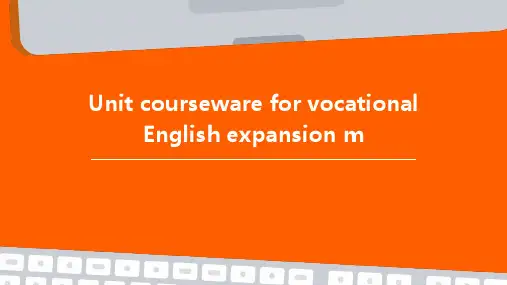
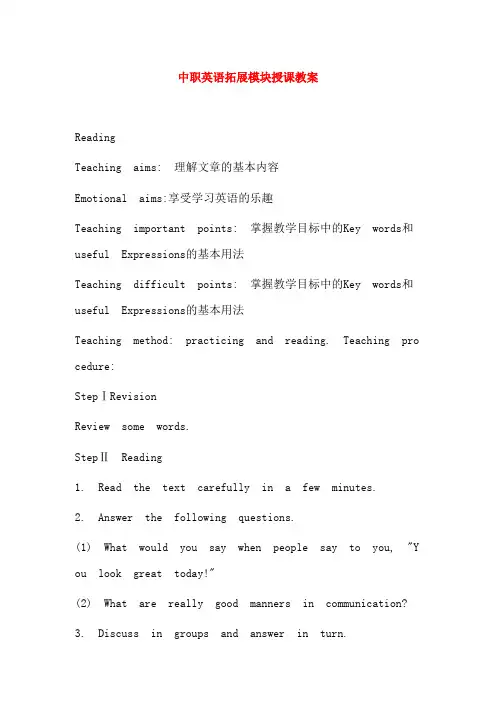
中职英语拓展模块授课教案ReadingTeaching aims: 理解文章的基本内容Emotional aims:享受学习英语的乐趣Teaching important points: 掌握教学目标中的Key words和useful Expressions的基本用法Teaching difficult points: 掌握教学目标中的Key words和useful Expressions的基本用法Teaching method: practicing and reading. Teaching pro cedure:StepⅠRevisionReview some words.StepⅡReading1. Read the text carefully in a few minutes.2. Answer the following questions.(1) What would you say when people say to you, "Y ou look great today!"(2) What are really good manners in communication?3. Discuss in groups and answer in turn.StepⅢKey words和Useful Expressions④Second, it is quite rude to talk with a person in your native language and leave your American frien ds standing there.其次,你用母语和一个人交谈而让美国朋友冷落一边是非常不礼貌的。
句中it作形式主语,不定式短语to talk with a person in your native language and leave your American friends standing there作真正主语。
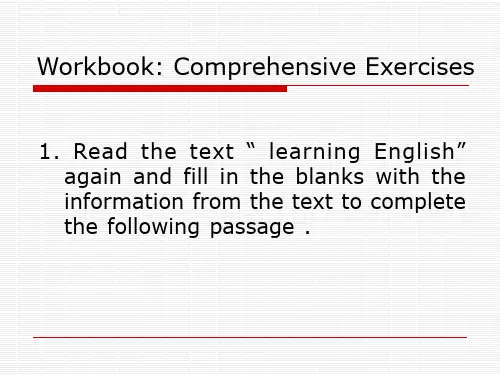
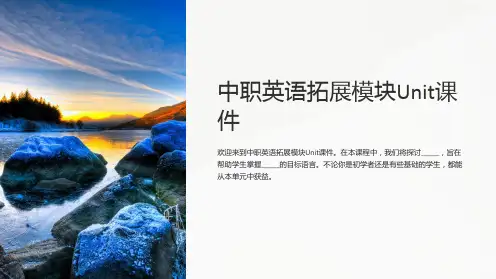
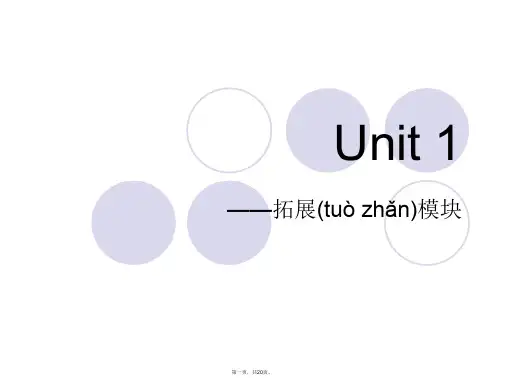
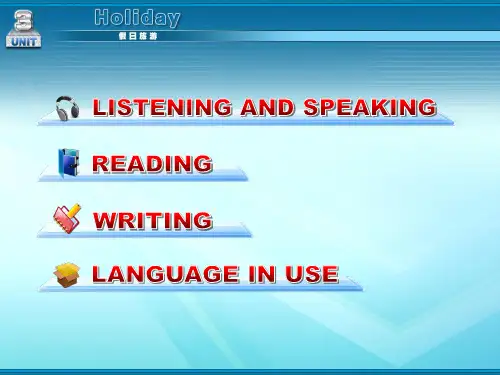
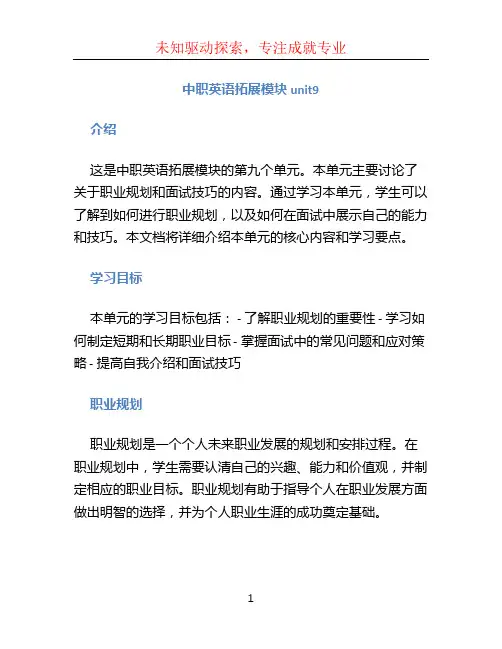
中职英语拓展模块unit9介绍这是中职英语拓展模块的第九个单元。
本单元主要讨论了关于职业规划和面试技巧的内容。
通过学习本单元,学生可以了解到如何进行职业规划,以及如何在面试中展示自己的能力和技巧。
本文档将详细介绍本单元的核心内容和学习要点。
学习目标本单元的学习目标包括: - 了解职业规划的重要性 - 学习如何制定短期和长期职业目标 - 掌握面试中的常见问题和应对策略 - 提高自我介绍和面试技巧职业规划职业规划是一个个人未来职业发展的规划和安排过程。
在职业规划中,学生需要认清自己的兴趣、能力和价值观,并制定相应的职业目标。
职业规划有助于指导个人在职业发展方面做出明智的选择,并为个人职业生涯的成功奠定基础。
制定职业目标制定职业目标是职业规划的重要步骤之一。
在制定职业目标时,学生应该考虑以下几个方面: 1. 兴趣和激情:什么样的工作能够激发你的兴趣和激情?你对哪个领域感兴趣? 2.能力和技能:你有哪些能力和技能?哪些工作需要你目前已有的能力和技能?3. 价值观和目标:你的价值观和目标是什么?你希望通过工作实现什么样的目标? 4. 市场需求:你所选择的职业是否有市场需求?是否具有发展潜力?通过综合考虑以上要素,学生可以制定出符合个人兴趣和目标的职业目标,并为实现这些目标设定相应的行动计划。
面试技巧面试是求职过程中的重要环节,成功的面试表现可以为你赢得心仪的工作机会。
在面试中,学生应当注意以下几点面试技巧: 1. 充分准备:在面试前,了解公司背景、岗位要求和行业动态。
准备好自己的简历和面试常见问题的答案。
2. 形象仪表:穿着得体、仪表整洁,给面试官一个良好的第一印象。
3. 自我介绍:介绍自己时要简明扼要地介绍个人背景、教育经历和工作经验。
强调与岗位要求相关的能力和技能。
4. 回答问题:在回答问题时要清晰明了,重点突出,且结合自己的实际经历给出具体的例子和证明。
5. 沟通能力:与面试官保持良好的沟通,积极参与面试对话。
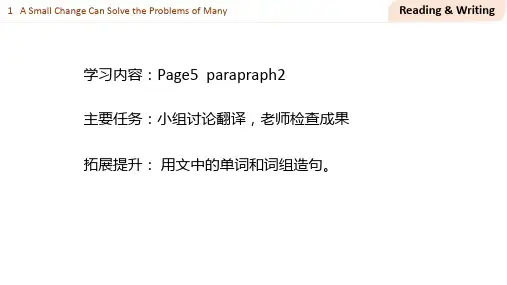
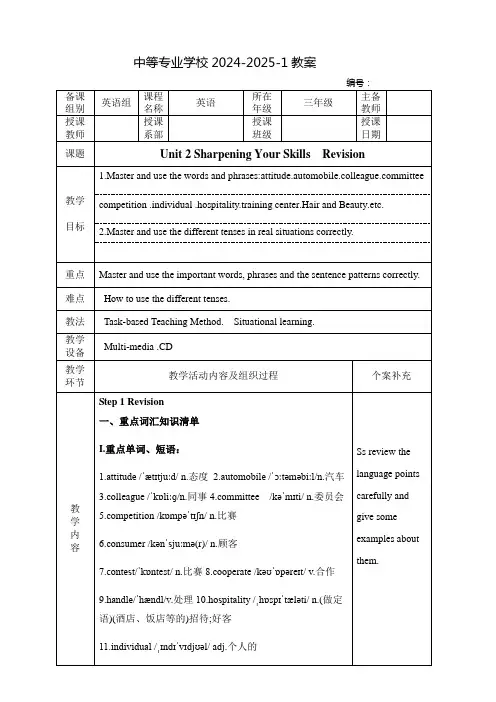
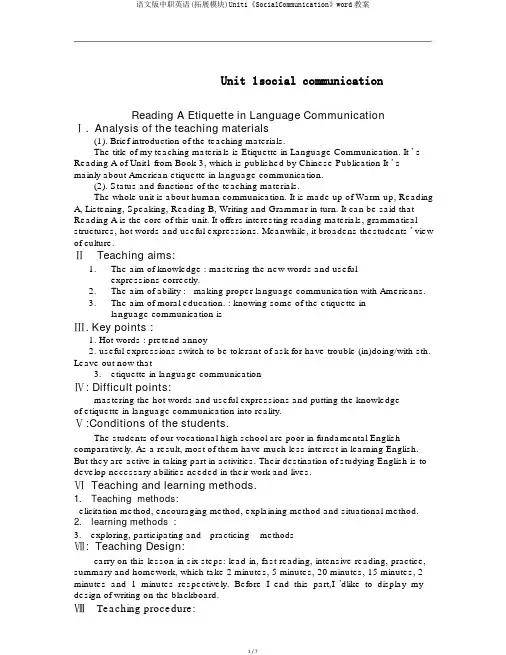
Unit 1s ocial communicationReading A Etiquette in Language CommunicationⅠ. Analysis of the teaching materials(1). Brief introduction of the teaching materials.The title of my teaching materials is Etiquette in Language Communication. It ’ s Reading A of Unit1 from Book 3, which is published by Chinese Publication It ’ s mainly about American etiquette in language communication.(2). Status and functions of the teaching materials.The whole unit is about human communication. It is made up of Warm-up, Reading A, Listening, Speaking, Reading B, Writing and Grammar in turn. It can be said that Reading A is the core of this unit. It offers interesting reading materials, grammatical structures, hot words and useful expressions. Meanwhile, it broadens thestudents ’ view of culture.ⅡTeaching aims:1.The aim of knowledge : mastering the new words and usefulexpressions correctly.2.The aim of ability : making proper language communication with Americans.3.The aim of moral education. : knowing some of the etiquette inlanguage communication isⅢ. Key points :1.Hot words : pretend annoy2. useful expressions switch to be tolerant of ask for have trouble (in)doing/with sth. Leave out now that3.etiquette in language communicationⅣ: Difficult points:mastering the hot words and useful expressions and putting the knowledgeof etiquette in language communication into reality.Ⅴ:Conditions of the students.The students of our vocational high school are poor in fundamental English comparatively. As a result, most of them have much less interest in learning English. But they are active in taking part in activities. Their destination of studying English is to develop necessary abilities needed in their work and lives.ⅥTeaching and learning methods.1.Teaching methods:elicitation method, encouraging method, explaining method and situational method.2.learning methods :3. exploring, participating and practicing methodsⅦ: Teaching Design:carry on this lesson in six steps: lead-in, fast reading, intensive reading, practice, summary and homework, which take 2 minutes, 5 minutes, 20 minutes, 15 minutes, 2 minutes and 1 minutes respectively. Before I end this part,I ’dlike to display my design of writing on the blackboard.ⅧTeaching procedure:Step 1 Lead in (2’)Tell a story , showing some pictures with wrong manners→Find mistakes××①②××③④Then ask the question:“What are wrong manners?”The students needn’tanswer the questionStep 2 fast reading (5)read fast → showing the pictures again→ give their answersThen ask the question:“What we should say/do here?”??①②??③③④Step 3 Intensive reading(20)1.read carefully ,then ask the question:“Why should we behave so?”2.key words and useful expressions→long sentences→ expansionokok②①ok ok③④Key words and expressions:In this step, I ’lltake three steps to present the key words and useful expressions. First, the usage. Then, show one or two model sentences. Last, to get the students to participate and practise, give them one or two sentences as exercises. The exercises can be in different forms, such as, filling in blanks, translating, correcting mistakes, and so on. All the exercises are done by the students themselves.be tolerant of/towards:Usage: be tolerant of/towards +n./ pron .Model sentences:1.Mr. Smith is not very tolerant of/towards others .2.We should always be tolerant of the views of others even if we disagree with them. Exercises:1.Fill in the blank with the right form of the given words:Her own mistakes made her very____( tolerant) of/towards others.Have some/no trouble(in)Usage: have some/no trouble(in) doing sth.Model sentences:I had some trouble (in) reading the letter . His handwriting is very bad.They had no difficulty in understanding what he said.Exercises:Translate the Chinese sentence into English:他们绝不费劲就找到了我的家。
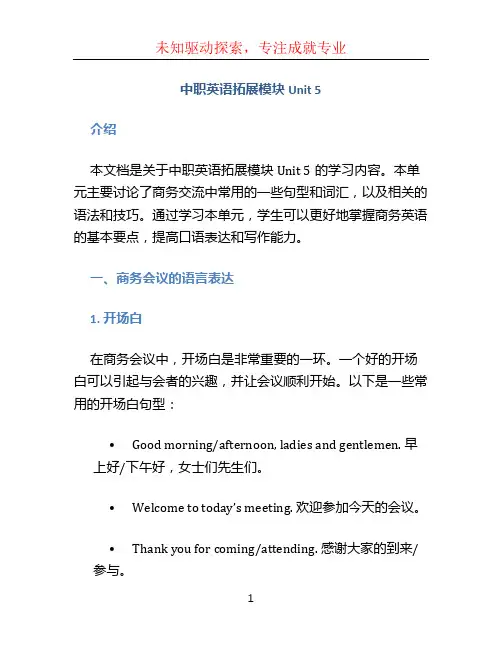
中职英语拓展模块Unit 5介绍本文档是关于中职英语拓展模块Unit 5的学习内容。
本单元主要讨论了商务交流中常用的一些句型和词汇,以及相关的语法和技巧。
通过学习本单元,学生可以更好地掌握商务英语的基本要点,提高口语表达和写作能力。
一、商务会议的语言表达1. 开场白在商务会议中,开场白是非常重要的一环。
一个好的开场白可以引起与会者的兴趣,并让会议顺利开始。
以下是一些常用的开场白句型:•Good morning/afternoon, ladies and gentlemen. 早上好/下午好,女士们先生们。
•Welcome to today’s meeting. 欢迎参加今天的会议。
•Thank you for coming/attending. 感谢大家的到来/参与。
•Let’s get started. 让我们开始吧。
2. 提出议程在商务会议中,需要明确会议的议程,以确保会议的目标达成。
以下是一些常用的提出议程的句型:•Let’s move on to the first item on the agenda. 让我们来进行第一项议程。
•The first item on the agenda is… 议程上的第一项是…•Our main focus today is… 今天的主要议题是…•We need to discuss… 我们需要讨论…3. 发表意见和建议在商务会议中,与会者需要积极参与讨论,并提出自己的意见和建议。
以下是一些常用的发表意见和建议的句型:•In my opinion, we should… 在我看来,我们应该…•I suggest that we… 我建议我们…•What if we… 如果我们…会怎么样?4. 辩论和达成共识在商务会议中,有时会有不同意见的辩论。
以下是一些常用的辩论和达成共识的句型:•I see your point, but… 我理解你的观点,但是…•I disagree. 我不同意。
Unit 3 Doing Our Part for the Environment第一、第二课时Listening and Speaking一、教学内容分析本课教学内容选自《英语拓展模块》第三单元“Doing Our Part for the Environment”听说板块(Listening and Speaking)。
本板块内容以环境保护为主题,共有四个短对话和两个长对话听力活动以及两个口头交际活动。
四个短对话分别从空气质量、塑料袋使用、植树、绿色出行等方面呈现了交际内容,目的是激活学生相关的语言知识和生活常识,同时让学生了解环境保护涉及生活的方方面面。
两个长对话的主题分别针对雾霾问题及环境保护举措,旨在训练学生通过听对话获取有关环境问题的信息及理解具体环保措施的能力,也为学生了解环保活动中个人行为的重要性提供了内容载体。
该板块教学内容要求在讨论环境问题与环境保护的语境中,学生能够听懂讨论环境问题和应对措施的对话,根据对话内容概况主人公的环保态度;熟悉描述环境问题的表达,口头简要介绍应对环境问题的措施和垃圾分类的知识;能够与同伴就日常生活中的环保举措进行讨论,体现“从我做起”的环保观念。
二、学情分析环境保护是与学生日常生活紧密相关的话题。
学生基本都有垃圾分类、绿色出行等与环境保护相关的生活经验,因而学生有进行本话题讨论的基础和素材。
同时,学生在基础模块中学习过绿色地球的话题,在了解有关环境问题的信息时,对于环境问题和垃圾分类等信息要素可进行迁移应用,如protect、recycle 等词汇以及“Paper, cans and bottles can be recycled.”和“We can help reduce waste and protect the environment.”等句型。
但学生对于应对环境问题的措施等内容较少进行深入交流,用英文描述更多环保举措还存在表达困难。
同时,学生存在话题词汇量少,自主获取知识和系统总结所学内容的意识较差,课堂上有表达的诉求,但往往受英语知识储备量所限,表达的意愿较弱,英语综合应用能力较弱,因而教师在课堂上通过模拟访谈的方式,由易及难,不断增强学生表达的自信心,提高表达能力。
高教版中职英语拓展模块unit2Unit 2 of the Higher Education Edition of Vocational English focuses on the topic of Creating. In this unit, students will learn various aspects related to creating and developing ideas, products, and solutions.The unit starts by introducing the concept ofcreativity and its importance in today's rapidly evolving world. Students will explore different techniques and strategies to enhance their creative thinking skills. They will learn how to generate ideas, think critically, and solve problems creatively.Furthermore, the unit covers the process of product development. Students will understand the different stages involved in creating a new product, from concept generation to market launch. They will learn about market research, product design, prototyping, testing, and manufacturing. The unit emphasizes the importance of teamwork andeffective communication in the product development process. In addition to product development, the unit also explores the concept of innovation. Students will delveinto the world of innovative ideas and learn about successful innovations that have changed industries andsociety. They will analyze case studies and discuss the factors that contribute to successful innovation.The unit also includes practical exercises and projects to encourage students to apply their knowledge and skillsin creating and developing their own ideas. They will have the opportunity to work on group projects, where they will brainstorm and develop innovative solutions to real-life problems.Furthermore, the unit introduces students to the world of entrepreneurship. They will learn about starting and running a business, including market analysis, business planning, financing, and marketing strategies. Studentswill also explore the traits and qualities of successful entrepreneurs and be encouraged to develop their own entrepreneurial mindset.Overall, Unit 2 of the Higher Education Edition of Vocational English provides students with a comprehensive understanding of the process of creating and developing ideas, products, and solutions. It equips them with the necessary skills and knowledge to succeed in today's competitive and innovative world.。